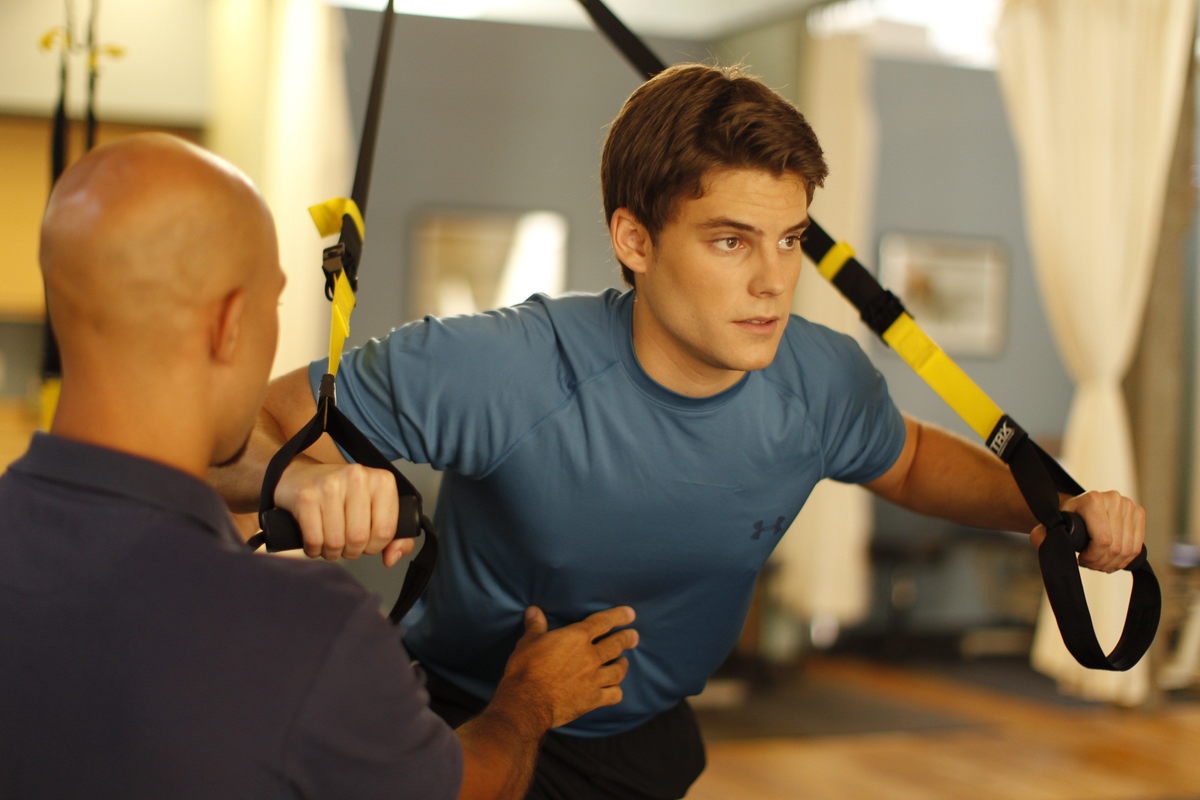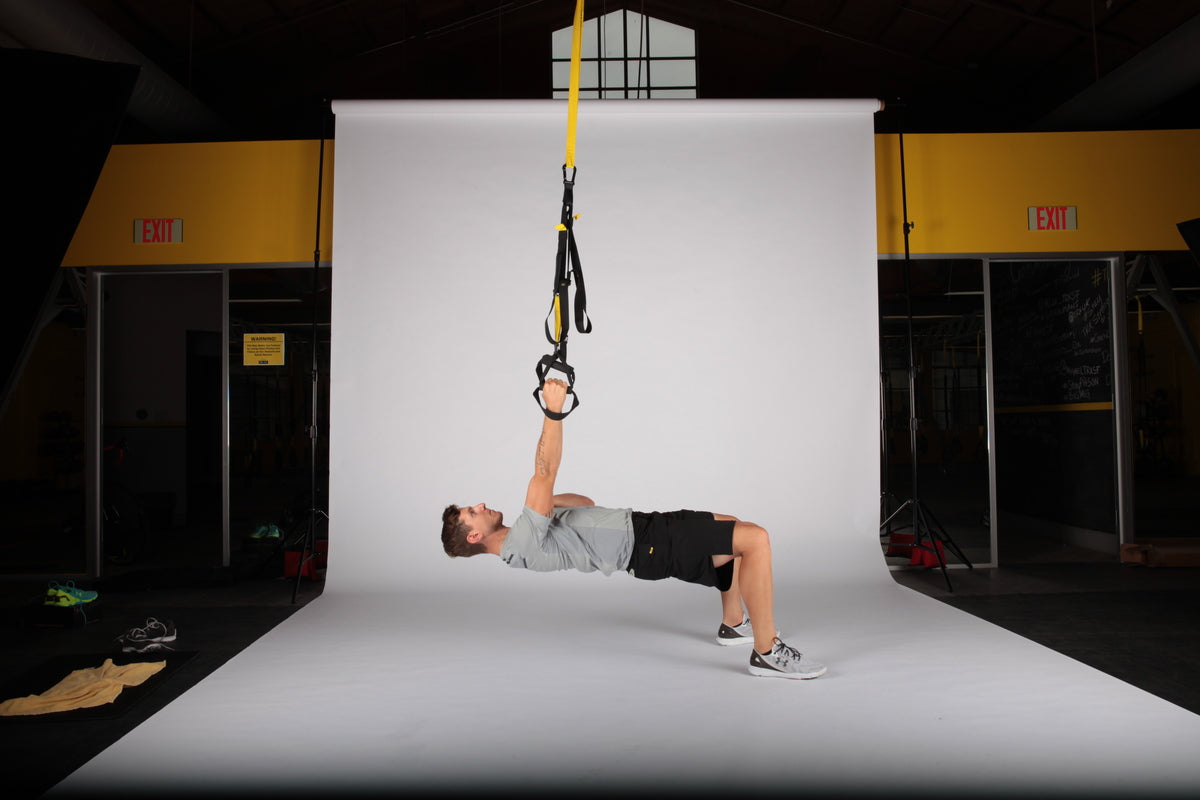Medicine balls can help enhance upper-body strength, power, and flexibility through throws and passes and significantly improve power production. These exercises efficiently develop explosive strength without the complex technique demanded by Olympic lifts. They are accessible and quick to learn, making them valuable additions to any strength training regimen.
5. Kneeling Lateral Underhand Pass
The kneeling lateral underhand pass effectively enhances coordination, core stability, and lateral movement. Use your choice of medicine ball, the exercise targets the core, shoulders, and obliques, contributing to improved functional strength and overall stability.
How to perform the Kneeling Lateral Underhand Pass:
- Starting Position: Begin by kneeling on the ground with an upright posture.
- Grip the Ball: Hold a medicine ball with an underhand grip, extending your arms straight out in front of you at chest level.
- Execute the Pass: Rotate your torso to one side while maintaining extended arms, and pass the ball to a partner or a designated spot on the floor.
- Return to Center: Rotate back to the starting position.
- Alternate Sides: Repeat the movement to the opposite side.
- Continue: Alternate sides for the specified number of repetitions or duration.
This exercise promotes dynamic stability and strength through controlled lateral movements while maintaining a kneeling position.
4. Split-Stance Scoop Throw
The split-stance scoop throw is an exercise designed to enhance power, coordination, and core strength. This movement involves standing in a split stance, with one foot forward and the other back, and using a scooping action to throw a ball or similar object. It targets the core, shoulders, and legs, contributing to improved athletic performance and stability.
How to perform the Split-Stance Scoop Throw:
- Starting Position: Begin in a split stance with one foot forward and one foot back.
- Grip the Ball: Hold a medicine ball with both hands near your hip on the side of your back foot.
- Perform the Scoop: Use a scooping motion to lift the ball up and across your body towards the opposite shoulder.
- Pivot and Transfer Weight: As you scoop, pivot on your back foot and shift your weight forward.
- Release the Ball: Throw the ball towards your target, following through with your arms.
- Reset and Repeat: Return to your starting stance and repeat the movement for the desired number of repetitions or duration.
This exercise enhances overall athletic performance by integrating core strength and coordination with a dynamic throwing motion.
Related: What are Medicine Balls For?
3. Underhand Vertical Squat Throw
The underhand vertical squat throw combines a squat with an underhand throw to enhance explosive power and coordination. This exercise is targets the legs, core, and shoulders by integrating a dynamic squat with an upward throw.
How to perform the Underhand Vertical Squat Throw:
- Starting Position: Stand with your feet shoulder-width apart.
- Grip the Ball: Hold a medicine ball at waist level with your palms facing up.
- Perform the Squat: Lower into a squat position, keeping your chest up and back straight.
- Explosive Movement: As you rise from the squat, extend your hips, knees, and ankles to jump vertically.
- Throw the Ball: Simultaneously extend your arms upward and release the medicine ball, aiming to throw it as high as possible.
- Land Softly: Absorb the impact through your legs as you land.
- Catch or Retrieve: Catch the ball if possible, or allow it to drop safely to the ground.
- Reset and Repeat: Return to the starting position and repeat for the desired number of repetitions.
This exercise helps develop explosive power by integrating lower body strength with an upper body throw.
2. Kneeling Medicine Ball Overhead Pass
The kneeling medicine ball overhead pass is an exercise aimed at enhancing upper body strength and core stability. This exercise involves kneeling and passing a medicine ball overhead to a partner or against a wall. It effectively targets the shoulders, arms, and core, contributing to improved coordination and power.
How to perform the Kneeling Medicine Ball Overhead Pass:
- Starting Position: Kneel on the ground with both knees hip-width apart.
- Grip the Ball: Hold a medicine ball with both hands, ensuring a firm grip.
- Prepare the Pass: Position the ball at chest level, close to your body.
- Execute the Pass: Push the ball upward and overhead, extending your arms fully.
- Engage Core: Keep your core engaged and maintain a stable posture throughout the movement.
- Return to Start: Lower the ball back down to chest level with control.
- Repeat: Continue the movement for the desired number of repetitions.
This exercise promotes upper body strength and core stability while enhancing overall coordination and power.
1. Downward Slam Throw
The downward slam throw is an exercise designed to develop power and explosiveness. It involves lifting a medicine ball overhead and then forcefully slamming it down to the ground. This movement engages the core, shoulders, and arms, providing a comprehensive full-body workout that enhances strength and coordination. Note, this is also a slam ball exercise.
How to perform the Downward Slam Throw:
- Starting Position: Stand with your feet shoulder-width apart, holding a medicine ball with both hands.
- Lift the Ball: Raise the ball above your head with extended arms.
- Engage Core: Tighten your core and maintain a stable stance.
- Execute the Slam: Forcefully slam the ball downward toward the ground, using your entire body for power.
- Follow Through: Continue the movement with controlled force.
- Catch or Rebound: Catch the ball on its rebound or allow it to bounce back up.
- Repeat: Perform the slam throw for the desired number of repetitions.
The Advantages of Utilizing Medicine Balls for Enhancing Power
Medicine balls are not only a full-body workout, but they help you mix up your workout with a fun twist. In addition to these benefits, here are four more advantages of incorporating medicine ball training into your regimen:
Simple To Use
While mastering Olympic lifts can be time-consuming, medicine ball power training provides a more accessible entry point for developing explosive power, particularly for those new to weightlifting. This approach allows individuals to focus on dynamic movements without the extensive learning curve associated with Olympic lifts.
Enhanced Physical Strength
Medicine ball power exercises are designed to activate fast-twitch muscle fibers through rapid contractions. These fibers are crucial for muscle hypertrophy and strength development, as they contribute significantly to explosive power and overall muscular performance.
Enhanced Physical Performance and Agility
Medicine ball training effectively enhances both speed and precision in athletic movements, including quick twists and directional changes. Its versatility enables training across multiple planes of motion, equipping athletes to meet the dynamic demands of sports and fitness activities.
Enhanced Fat Burning
Activating the fast-twitch muscles in your arms and legs increases calorie expenditure during your workout and elevates your metabolic rate for up to 14 hours afterward.
Related: TRX Medicine Ball Exercise
Recommendations for Medicine Ball Training
Start With These Moves
Performing medicine ball power exercises is ideally positioned between your warm-up and strength training sessions. This timing ensures that your muscles are sufficiently warmed up but not yet fatigued, which optimizes your power output. Since power exercises place significant demands on both the neurological and muscular systems, executing them while you are fresh enhances their effectiveness. Additionally, incorporating power exercises at this stage primes your fast-twitch muscle fibers, setting a strong foundation for the weightlifting that follows and improving the overall efficacy of your training session.
Take It Easy
Power involves moving weight quickly, so it is crucial to select a medicine ball that allows for efficient repetition. Using a ball that is too heavy can impair your form and reduce the velocity needed for optimal power development. For most exercises, starting with a medicine ball weighing between 4 to 4.5 kg is recommended, although the exact weight should be adjusted based on the specific movement being performed.
Do Fewer Reps
When aiming for high power output, prioritize the quality of each repetition over the quantity. Each repetition should be performed with speed, intensity, and fluidity to maximize effectiveness. Maintaining optimal form throughout the exercise is crucial; if repetitions begin to slow down or lose force, it may indicate that you have reached your capacity for that set. Generally, starting with three to five repetitions is recommended for exercises that require maximum power output.



